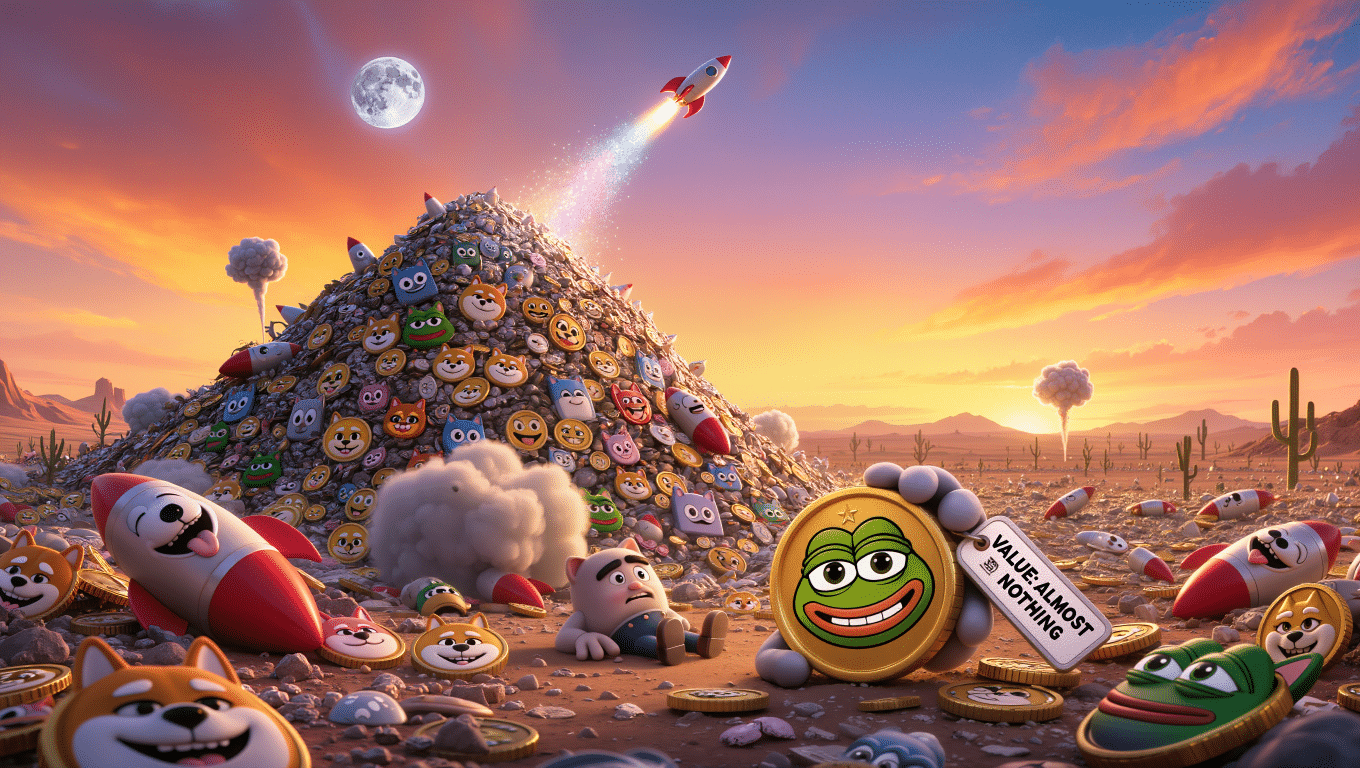Why Your Grandson’s “Investment” in DogeBonk Probably Isn’t Going to Pay Off
Remember the housing bubble when people were flipping condos like pancakes and insisting real estate only goes up? Well, history has a sense of humor – and it’s given us meme coins, the digital equivalent of buying swampland in Florida because someone on the internet said it was a good investment.
Hello folks. Walter here, and today we need to talk about something that makes even seasoned cryptocurrency enthusiasts shake their heads: meme coins. If Bitcoin is digital gold and Ethereum is a digital computer, then meme coins are… well, they’re the subprime mortgages of the crypto world, except this time instead of overleveraged homeowners, we have people betting their savings on tokens named after dogs and internet jokes.
And somehow – somehow – billions of dollars have flowed into these things.
What Exactly ARE Meme Coins?
Let me explain this as simply as I can: meme coins are cryptocurrencies created as jokes, based on internet memes, or launched purely for entertainment with little to no practical utility.
Think of it this way – if Bitcoin was created to solve the problem of centralized money, and Ethereum was built to enable decentralized applications, meme coins were created because someone thought, “You know what the world needs? A cryptocurrency based on that funny dog picture.“
And somehow – somehow – billions of dollars have flowed into these things.
The Basic Characteristics of Meme Coins:
- No real use case beyond speculation and community entertainment
- Extremely volatile – can swing 500% up or down in a day
- Powered by social media hype rather than technology or fundamentals
- Often created in minutes using simple token-generation tools
- Named after jokes, animals, or internet trends that will be forgotten next month
The Hall of Shame: Some Spectacularly Stupid Meme Coins
Now, I’m not making these up. These are real cryptocurrencies that real people have invested real money in:
The “Are You Kidding Me?” Category:
1. Dogelon Mars (ELON)
A coin combining Dogecoin, Elon Musk, and Mars colonization. Because apparently one meme wasn’t enough – they needed three.
2. Shiba Inu (SHIB)
Created as the “Dogecoin killer,” it’s a meme coin trying to kill another meme coin. It’s like watching two inflatable tube men fight outside a car dealership.
3. SafeMoon
The name alone should tell you to run. Any investment with “Safe” in the name usually isn’t. It’s like a restaurant called “Definitely Not Food Poisoning.”
4. Floki Inu
Named after Elon Musk’s dog. Yes, people invested in a cryptocurrency named after a billionaire’s pet.
5. Baby Doge Coin
Because regular Doge apparently needed a baby. I wish I were making this up.
The “This Can’t Be Real” Category:
Jesus Coin – Cryptocurrency that claims to save your soul
PotCoin – For marijuana transactions (at least it has a use case?)
DentaCoin – For dental services (because Bitcoin wasn’t good enough for your dentist?)
Cumrocket – I won’t elaborate on the etymology here, but you can probably figure it out
Toiletpapercoin – Created during the 2020 pandemic toilet paper shortage
And my personal favorite for sheer audacity:
Ponzicoin – Literally advertised as a Ponzi scheme. At least they were honest about it.
How Meme Coins Relate to Bitcoin and Ethereum
Here’s the thing that frustrates serious cryptocurrency advocates: meme coins exist because of the infrastructure built by Bitcoin and Ethereum, but they contribute almost nothing back to the space except noise and scams.
The Technical Relationship:
Bitcoin’s Role:
Bitcoin pioneered the technology and proved cryptocurrency could work. It created the market that allows meme coins to exist. But Bitcoin itself is serious technology with a clear purpose – it’s like the foundation of a house.
Ethereum’s Role:
Most meme coins are built on Ethereum (or similar platforms like Binance Smart Chain). Ethereum made it incredibly easy to create tokens – you can literally launch a cryptocurrency in about 15 minutes without understanding any of the underlying technology.
It’s like Ethereum accidentally created the world’s easiest printing press for Monopoly money, and people discovered they could sell that Monopoly money to other people for real dollars.
Why Are There SO MANY Meme Coins?
The short answer? Because it’s absurdly easy to create one, and for a brief moment in 2021, some people became millionaires from them.
The Ugly Economics:
Creating a meme coin requires:
- About $500-1,000 in setup costs
- 15-30 minutes of technical work
- Zero actual innovation
- A clever name and logo
- Social media hype
The potential payoff? If you can convince enough people to buy in, you could theoretically make millions before the whole thing crashes.
It’s the modern version of a pump-and-dump scheme, except it’s all out in the open and somehow legal in many jurisdictions.
The Numbers Are Staggering:
- Over 2.5 million cryptocurrencies have been created
- Approximately 90-95% are completely worthless
- Thousands are created every single day
- Most die within weeks or months
- The market is littered with “dead coins” that will never trade again
The Worthless Rubbish Problem
Here’s what makes me particularly frustrated about meme coins: they make the entire cryptocurrency space look like a joke.
When your neighbour tells you Bitcoin is a scam, it’s often because they heard about someone who lost money on “SafeElonMoon” or whatever nonsense coin was trending that week.
The Typical Meme Coin Lifecycle:
Day 1-7: Launch with explosive social media marketing
Week 2-4: Price pumps as speculators rush in
Month 2: Early investors sell, price crashes 90%
Month 3-6: Slow decline as reality sets in
After 6 months: Effectively dead, but technically still exists on the blockchain forever
How to Identify Worthless Meme Coins:
- Promises of “going to the moon” – Financial literacy red flag
- Anonymous developers – Who are you giving your money to?
- No whitepaper or roadmap – They literally don’t know what they’re doing
- Celebrity endorsements from non-financial experts – Kim Kardashian promoting crypto is not investment advice
- Aggressive marketing on social media – Real investments don’t need to spam Twitter
- “Tokenomics” that make no sense – Quadrillions of tokens, weird redistribution schemes
- Names designed to be viral – FlokiSafeMoonElonBabyDoge is not a serious project
The Exception: Successful Meme Coins (But Don’t Get Excited)
I’d be dishonest if I didn’t mention that a tiny handful of meme coins have achieved something resembling legitimacy:
Dogecoin (DOGE)
The Original Meme Coin:
- Created in 2013 as a literal joke
- Market cap has reached over $80 billion at its peak
- Actually used for tips and small transactions
- Has maintained a community for over a decade
But here’s the reality: Dogecoin succeeded despite being a joke, not because of it. It got lucky with timing, celebrity endorsements (Elon Musk), and an accidentally wholesome community.
Shiba Inu (SHIB)
The Dogecoin Competitor:
- Created as “Dogecoin killer”
- Built an ecosystem with DEX (ShibaSwap) and NFTs
- Market cap reached $40+ billion at peak
- Actually attempting to build utility
The catch: Even at its peak, most serious investors considered it speculation, not investment.
Why These “Succeeded” (Sort Of):
| Success Factor | Why It Worked |
| Timing | Launched during crypto bull markets |
| Community | Strong, engaged communities formed |
| Celebrity Attention | Elon Musk tweets moved markets |
| Accessibility | Extremely cheap per token, psychological appeal |
| Longevity | Survived longer than 99% of other meme coins |
But here’s the crucial point: For every Dogecoin that survived, there are 10,000 meme coins that went to zero.
The Bottom Line: Stay Away From Meme Coins
Look, I know it’s tempting. You hear stories about someone turning $100 into $100,000 on some ridiculous dog coin, and you think, “Why not me?”
Here’s why not:
The Brutal Math:
- For every winner, there are hundreds of losers who bought at the top
- You’re competing against insiders who got in early and will dump on you
- The odds are worse than a casino – at least casinos are regulated
- There’s no underlying value – when the music stops, there’s nothing left
What You’re Really Doing:
When you buy a meme coin, you’re not investing – you’re gambling that you can sell to someone else at a higher price before everyone realizes it’s worthless. That’s not investing, that’s the Greater Fool Theory in action.
It’s like musical chairs, except 95% of the players lose their chairs, their money, and their dignity.
The Opportunity Cost:
Every dollar you put into “BabyDogeElonSafeMoon” is a dollar you didn’t put into:
- Bitcoin (which has survived 16 years)
- Ethereum (which powers actual applications)
- Traditional investments (stocks, bonds, real estate)
- Your grandkids’ education fund
My Final Advice: The Three Rules of Meme Coins
Rule #1: Don’t buy meme coins.
Rule #2: If you ignored Rule #1, only invest money you’re prepared to lose 100% of – and I mean literally prepared to watch it go to zero.
Rule #3: If you ignored Rules #1 and #2, at least understand you’re gambling, not investing. Set a stop-loss, take profits quickly, and get out before the inevitable crash.
If someone you care about is excited about a meme coin, don’t lecture them – but do ask these questions:
- “What problem does this solve?”
- “Why will it be valuable in five years?”
- “Who created it and what’s their track record?”
- “What percentage of your money are you risking?”
The answers will usually reveal the truth: it’s speculation based on nothing but hype.
The existence of meme coins doesn’t mean cryptocurrency as a whole is a scam. But they do reveal that this space is still immature, poorly regulated, and filled with people trying to make quick money off others’ ignorance.
Bitcoin and Ethereum have genuine technological innovation and real-world use cases. They’re attempting to solve actual problems with money and applications.
Conclusion: The Digital Snake Oil
Remember when I said at the beginning this was like the housing bubble when people were flipping condos like pancakes? I was being generous. At least real estate was actual property you could live in or rent out, even when the market crashed. Meme coins are worse – they’re digital nothing backed by internet jokes, promising riches while delivering losses to 95% of participants.
Meme coins are worse – they’re digital snake oil sold to people through social media hype, promising riches while delivering losses to 95% of participants.
If you take away one thing from this blog, let it be this:
The fact that something made some people rich doesn’t mean it’s a good investment for you. For every lottery winner, there are millions of losers who bought tickets. The house always wins, and in meme coins, the house is the anonymous developers and early insiders who dump on everyone else.
Stick to investments you understand. If you’re interested in cryptocurrency, learn about Bitcoin and Ethereum first. They’re complex enough – you don’t need to add meme coins to the mix.
And if someone tries to tell you about the next “SafeMoonElonDogeRocket,” just smile politely and change the subject. Your financial future will thank you.
Because your money is too important to bet on a joke – even if the joke managed to fool millions of people into thinking it was a good idea.







Leave a Reply